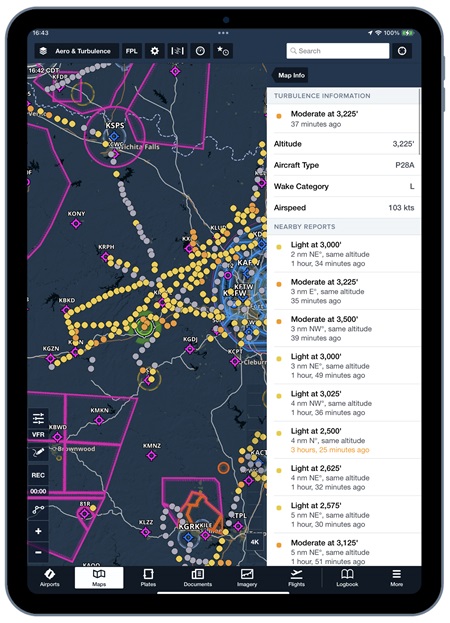New ForeFlight layer shows turbulence
Near-real-time reports leverage Sentry data
A new feature from ForeFlight leverages data from the company’s Sentry ADS-B receivers to show where aircraft are actually encountering turbulence.
“People tend to only report turbulent air, but you don’t actually know where there’s smooth air,” said ForeFlight Senior Product Manager Cole Crawford. The Reported Turbulence layer shows smooth air as a series of gray dots along an aircraft’s flight path; yellow, orange, and dark orange dots indicate light, moderate, and severe turbulence, respectively. Tap on a dot to show the reporting aircraft’s altitude, airspeed, and type and the age of the report.
Although the FAA defines levels of turbulence from light through extreme, pilots’ interpretations vary. By contrast, the levels of turbulence for ForeFlight’s new feature are determined by algorithm. Attitude sensors within the Sentry and Sentry Plus devices measure and record the level of turbulence throughout the flight, and the receivers upload the data whenever an internet connection is available. The more Sentry devices in the air, the more data available to pilots—and Crawford put the number of Sentry and Sentry Plus units in the tens of thousands.

A demo of the feature on a recent afternoon showed a cluster of training traffic in Florida and dotted lines crisscrossing the country. An altitude slider to the right of the screen filters in 3,000-foot increments in the lower altitudes. Pilots with Performance Plus subscriptions also can display turbulence in profile view to aid in selecting an altitude for the smoothest ride.
“No one enjoys flying through turbulence, whether you’re piloting a single-engine piston or riding in the back of a jet,” said Henrik Hansen, ForeFlight’s chief technology officer. “That’s why we’re thrilled to provide this groundbreaking new tool for planning around turbulence using actual inflight turbulence data, a capability most pilots have never had access to before. This innovation is a testament to our cutting-edge engineering and robust product design, as well as the transformative potential of portable ADS-B when widely adopted. We’re excited to see how this feature enhances flight planning and flying for all ForeFlight users.”
Reported Turbulence is available for Pro Plus plans and above as two subscription add-ons: Low, for reports up to 14,000 feet, and All, which extends to all altitudes. General aviation pilots who register their Sentry or Sentry Plus devices receive Low for no extra cost and a 50-percent discount on the All layer. Add-ons for individual customers without registered devices are $50 per year for Low and $100 per year for All. For business and enterprise pricing, contact ForeFlight sales staff.
For additional information, see this ForeFlight blog post or the release notes.




